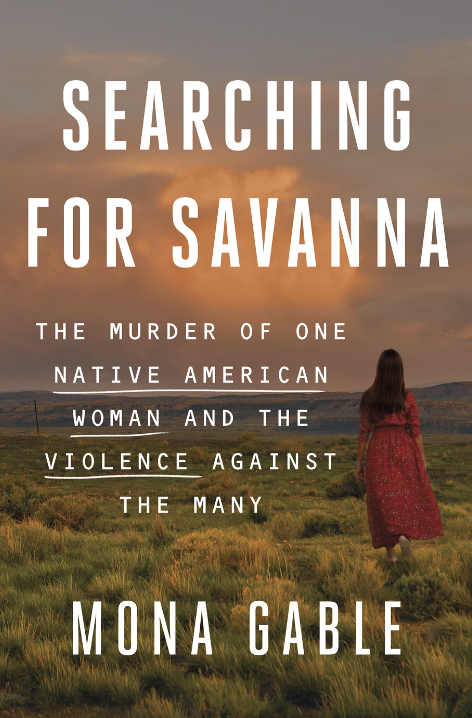Excerpt From Searching for Savanna: The Murder of One Native American Woman and the Violence Against the Many
Chapter Thirty-One: Red Dresses
 They flew in the freezing winter wind, flapping like birds’ wings. Forty red dresses. They hung from bare tree branches, along pale limestone walls, stood in pools of clear trickling water. As people walked past, bundled in scarves, knit caps, heavy coats, they glanced at the silhouettes outside the curvilinear National Museum of the American Indian, in Washington, DC. Some young women, arrested by the eerie display, stopped, took the dresses in. Touched them.
They flew in the freezing winter wind, flapping like birds’ wings. Forty red dresses. They hung from bare tree branches, along pale limestone walls, stood in pools of clear trickling water. As people walked past, bundled in scarves, knit caps, heavy coats, they glanced at the silhouettes outside the curvilinear National Museum of the American Indian, in Washington, DC. Some young women, arrested by the eerie display, stopped, took the dresses in. Touched them.
It was March 2019, Women’s History Month, and an installation called “The REDress Project” was premiering in the United States. Curated by Canadian artist Jaime Black, who is Métis, the dresses represented missing or murdered Indigenous women. Rich in meaning, the color red was “our sacred lifeblood,” Black told an interviewer. “It’s where our vitality comes from and our energy and our power as human beings.” It also alluded to the loss of that lifeblood through violence.
Since Black had begun soliciting dresses for her project, hundreds had poured in. Isolated, shed of women’s bodies, they were meant to command attention, elicit awareness of the MMIW issue in Canada and America, stir discussion. To offer a healing space for Native women who’d suffered violence, for families with missing or murdered loved ones to grieve.
A few blocks away on Capitol Hill the same week, awareness of MMIW and its complexities seemed to be regressing. A bill to renew the Violence Against Women Act, which expired in 2018, was being discussed in a hearing by the House Committee on the Judiciary. At issue was the groundbreaking 2013 provision that allowed tribes to prosecute non-Indians for domestic violence on tribal lands. Although it didn’t extend to other violent crimes like sexual assault, rape, and sex trafficking that Native advocates wanted, it was viewed as a crucial step in protecting women in Indian Country. After VAWA13 was put into effect by certain tribes, prosecution of non-Indian men who’d committed domestic violence against Native women rose significantly. But there were also acquittals, indicating the tribal justice system worked for non-Native defendants.
As he addressed the judiciary committee, Representative Jim Sensenbrenner, a Republican representing Wisconsin, appeared not to know, to apprehend, this. He argued the reauthorization bill was unconstitutional, wanted to scrap the tribal jurisdiction provision entirely. To that end, the white-haired conservative proposed an amendment to H.R.1585. “I have been on this committee for forty years,” he said emphatically. “We have never had a hearing on whether we should take away the constitutional rights of non-Indians who ended up being charged in tribal court.
Representative Jerry Nadler, the chair of the committee, a Democrat from New York, urged bipartisan support. But every GOP member sided with Sensenbrenner, voting for his amendment. Native advocates were blindsided. Juana Majel-Dixon, the secretary of the National Congress of American Indians, and cochair of a national task force to prevent violence against American Indian and Alaska Native women, told reporters, “I was disheartened, and frankly appalled, to see an amendment offered that would have stripped tribal governments of their inherent authority to hold non-Indians accountable for domestic violence crimes on tribal lands.”
In the end, Democrats had the majority, so Sensenbrenner’s amendment failed, H.R.1585 was approved. But not a single Republican voted for it.
Two days later, a historic event occurred in Washington, DC. The first- ever hearing in the House of Representatives on the “hidden” MMIW crisis. It had been called by the House Subcommittee on Indigenous Peoples of the United States.
At 9 a.m., about two dozen people gathered in a room in the Longworth House Office Building. The mood was quiet, somber. Representative Deb Haaland of New Mexico, a committee member, had made MMIW her signature issue. Recently elected, one of only two Native female members of Congress, she had already helped push two bills that addressed the crisis: Savanna’s Act and, her own measure, the Not Invisible Act. Her presence was strong. In honor of missing and murdered Indigenous women, she told her colleagues this morning, she had worn red.
Within minutes, Representative Ruben Gallego of Arizona, the committee chair, mentioned the murder of Savanna, the fate of other Native women and girls. There were some expert witnesses testifying. Sarah Deer, a citizen of the Muscogee Creek Nation of Oklahoma, the professor of women, gender, and sexuality studies at the University of Kansas. The lawyer also served as chief justice for the Prairie Island Indian Community Court of Appeals. In her prepared statement, she thanked the committee for inviting her in the Mvskoke language.
Sitting at a table, she emphasized the historical underpinnings of the MMIW crisis. “Native women and girls have been disappearing since 1492,” she said, “when Europeans kidnapped Native people for shipment back to Europe. The targeted killing of Native women is also not a new phenomenon.”
She highlighted the stunning lack of numbers, the absence of any “formal government-funded national database” that tracks cases of MMIW.
There was, she noted without irony, an Indigenous-led organization doing precisely that: the Sovereign Bodies Institute (or SBI). Since 2015, the nonprofit had been culling data from family members and through open-source reporting, trying to grasp the problem’s scope.
About the Author
 Mona Gable is a writer/author who has covered violence against Indigenous women over the years, including releasing her recent book Searching for Savanna: The Murder of One Native American Woman and the Violence Against the Many and an article honoring Tillie Black Bear in the Smithsonian Magazine. She released her book April.
Mona Gable is a writer/author who has covered violence against Indigenous women over the years, including releasing her recent book Searching for Savanna: The Murder of One Native American Woman and the Violence Against the Many and an article honoring Tillie Black Bear in the Smithsonian Magazine. She released her book April.
For more information or to purchase Searching for Savanna, please check out
www.mona-gable.com.





